|
An In Box Kit Preview of the German halftrack mittlere Schützenpanzerwagen
(Sd.Kfz. 251) Ausf. A and Ausf. B in 1/72 scale
The kits previewed:
- First To Fight kit PL1939-040 Sd.Kfz. 251/1
- Modell Trans Modelbau kit #72309 Sd.Kfz. 251/1
- First To Fight kit PL1939-053 Sd.Kfz. 251/4
- First To Fight kit PL1939-043 Sd.Kfz. 251/6
A Wee Bit Of History For
The Modeler
The basic Sd.Kfz. 251 began as an armored personnel carrier enabling
infantry, Panzergrenadiers, to keep up with the panzers, but it became
so much more. The vehicle is based on the chassis of the Sd.Kfz. 11
3-ton towing tractor. The Sd.Kfz. 251 is characterized by the long body,
the track run going about 2/3 the length of the body, sloped armor plate,
and open top. There were not many Sd.Kfz. 251 Ausf. A or Ausf. B produced
compared to the later Ausf. C and Ausf. D versions.
The Sd.Kfz 251/1 was the designation for the infantry version that carried
a crew of 12. Included in this kit preview also are models of the Sd.Kfz.
251/4 für I.G.-Munition mittlere Schützenpanzerwagen which
was an ammunition supply vehicle for the 7.5 cm le.IG.18 Infantry gun,
and the Sd.Kfz 251/6 als Fuehrerfahrzeug mit Funkeinbauten mittlere
Kommandopanzerwagen, a command and radio communications vehicle. The
Sd.Kfz. 251/4 can also be modeled as an Sd.Kfz. 251/3 für Infanterie-Geschütz
towing vehicle for the 7.5 cm le.IG.18.
The Sd.Kfz. 251 Ausf. A was the first production version and differed
from the Sd.Kfz. 251 Ausf. B in having two vision slits on each side
of the rear compartment. These slits were deleted from the Ausf. B and
later variants. The Sd.Kfz 251 Ausf. A and Ausf. B had simple bench
seats with hinges to lift them up for storing boxes and gear underneath.
There was no backrest and storage bin but a shallow shelf for the infantry
packs which would serve as a backrest. Six rifles and two spare machine
gun barrels were attached with brackets to the underside of the upper
armor. On the front was a bumper that was deleted in the Ausf. C and
Ausf. D versions.
An interesting variant produced is the mittlere ungepanzerte Mannschaftstransportwagen
Sd.Kfz 251. Ungepanzerte means unarmored. According to Jentz's book,
due to a shortage of hardened armor plate, from 1939 to December 1941,
305 were produced with 4-mm unhardened steel. The thinner unhardened
plate was proof against regular rifle bullets but not against armor-piercing
bullets. The only visible difference I can see is that the side plates
and rear door plates are bent into shape rather than being made of separate
welded plates.
Jentz also states that during production this vehicle was never referred
to as a "Hanomag" despite what is on the kit box art below and in other
references. Hanomag was one of the six producers.
The Box Art
First To Fight models have a unique shtick in modeling those vehicles
that were the "first to fight" in the European theatre in WW2: the Polish
campaign of September 1939. As Sd.Kfz. 251 production began in June
1939, I suspect only the Ausf. A would have served during this campaign.
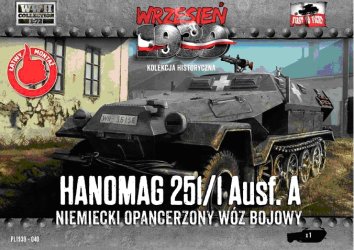
First To Fight kit 040 Sd.Kfz. 251/1 Ausf. A: Here is what appears to
me to be an accurate Sd.Kfz. 251/1 Ausf. A. The First To Fight kits
are new to me and up until these were released, the only Sd.Kfz. 251/1
Ausf. A or Ausf. B kits I was aware of were the resin Model Trans Modelbau
kit reviewed below, and the veteran Fujimi plastic kit which is 1/76
in length but 1/72 in width.
Atop the driver's compartment is a heavy MG34 machine gun mount rather
than the swinging mount fitted on the rear. On the front driver's plate
are the visors for the driver and commander/radio operator which lift
up and are backed by glass blocks. On the side of the superstructure
are the visors for the driver, and two for the crew compartment indicating
this is an Sd.Kfz. 251 Ausf A. Shave and sand these visors off the model
and we have an Ausf. B. Just in front of the driver's side visor are
vertical turn signals like those seen on German trucks.
At the bow we have a more pointy nose than on the Ausf. C and Ausf.
D hulls. On the lower part of the nose, and on the engine compartment
sides are ventilation flaps. Also on the nose is a tubular bumper with
a tow cable wrapped around it. The fender over the track is flat while
on the Ausf. C and Ausf. D versions the mudguard was bent up over the
sprocket wheel. On the fender are three storage boxes mounted towards
the front and handtools mounted on the hull side.
The front wheels are not powered like on the American M2 and M3 halftracks.
The long suspension has interleaved roadwheels that the Germans seemed
to favor. The vehicle is missing the width indicators and mirror that
should be on the corner of the front mudguards.
The vehicle is finished in Dunkelgrau Nr. 46, dark gray, with simple
white national crosses used at this time, and with painted on license
plates for an Army (Heer) halftrack. At this time German armor would
often also have a base coat of 2/3 Dunkelgrau and a second color of
soft edge of 1/3 Dunkelbraun Nr. 45, dark brown. Vehicles could be repainted
by individual units as fitting the area.
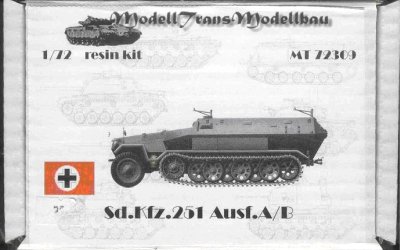
The box art for the Modell Trans Sd.Kfz. 251 Ausf. A/B kit MT 72309
shows a basic port side view of an Ausf. A vehicle in Panzer Gray color,
no markings are shown. The kit is listed on the box as an "Ausf. A/B"
as it contains appropriate parts for both versions.
The halftrack has the two machine gun mounts with swinging arm mounts
for optional use in the anti aircraft role; some Ausf. A and Ausf, B
were later upgraded with a front shield MGmount. On the side we see
the visors for the crew compartment and brackets for the handtools but
no tools like shovels and pick. On the front mudguard over the tire
is the vehicle width indicator with a rear view mirror attached. At
the lower rear end we see the towing pintle. The color is a monotone
panzer gray but no white cross or balkenkreuz.
This artwork on the FtF and Modell Trans we see how the track mudguard
is flat from fore to aft. On the Ausf. C and Ausf. D the track's mudguard
upturns over the sprocket wheel. Apparently there was a problem with
the track slapping the flat mudguard at high speed. On the Ausf. C and
Ausf. D the mudguard storage boxes were moved aft, and the handtools
moved to the mudguard.
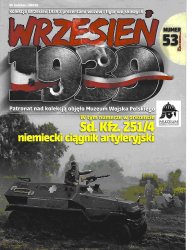
First To Fight's (FtF) box art and supporting magazine for Kit 053 Sd.Kfz.
251/4 depict what look like on the exterior to be an Sd.Kfz. 251/1 Ausf.
A. What makes it a Sd.Kfz. 251/4 are the storage boxes for the 7.5 cm
ammunition replacing some of the interior bench seats. At right is a
painting of a le.I.G. 18 light Infantry gun that this vehicle would
supply or tow. A vehicle commander figure is depicted and there is one
figure included with the model. In front of the figure is a good view
of the initial Sd.Kfz. 251 machine gun mount before being replaced by
the mount with a shield.
Unlike the painting for the FtF kit 040 above, this artwork shows the
front width indicators next to the headlights; otherwise equipment,
markings and vehicle color is the same as with kit 040 above. With some
new markings this Schützenpanzerwagen (SPW) could be modeled in
France or on the Russian Front in 1940 to 1942. The driver's visors
and commander's side visor are depicted open. In front of the commander's
side visor is a turn signal, the thing that looks like a vertical gray
stick. There should be a seam just behind the commander's side visor
where the middle (driver area) armored body section bolts to the rear
armor body section (the crew/passenger compartment) with an internal
flange.
At the lower right corner of the box are little symbols indicating the
kit contains parts for one vehicle and one crew figure. The kit title
on the box is in Polish.

This is the back side of the Sd.Kfz. 251/4 kit box with painting and
marking guide at left, and tiny, barely readable assembly instructions
at right. Perhaps FtF assumes that since we build small models we must
have great eyesight and prefer diminutive instructions? Fortunately
this kit has fewer parts than Revell's and Hasegawa's Sd.Kfz. 251 kits
so should be easier to assemble. Having not built one yet, I cannot
comment on the fit of the parts and any errors.
Except for the two ammunition boxes (parts G1 and G2) this kit and assembly
is the same for the Sd.Kfz. 251/1 SPW. The overhead drawing at left
shows us the placement of the ammunition boxes.
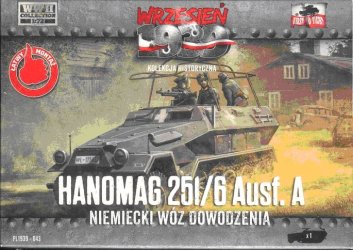
The box art for First To Fight's Kit 43, Sd.Kfz 251/6 als Führerfahrzeug
mit Funkeinbauten mittlere Kommandopanzerwagen, a radio and command
vehicle showing the large frame aerial atop the body, otherwise it appears
like a Sd.Kfz. 251/1. This large, very visible antenna was a dead giveaway
that the vehicle was a command SPW and therefore a prime target; later
versions had vertical copper rod and rod & star antenna.
This is a good view of the two deadlights and the Notek light on the
nose, and the width indicators attached to the fenders over the front
wheels. The viewports on the body side show this to be a Sd.Kfz. 251
Ausf. A. We see a line on the side that appears to be the seam where
the two body sections bolt together, but this seam should be behind
the side visor, not cutting though the visor. The side engine vent and
the driver's visor are open, even though both are molded closed on the
model.
The license plate number begins with "WL" indicating this is a Luftwaffe
vehicle, not an army (Heer) SPW. Three crew members are shown but no
figures are included with the model.
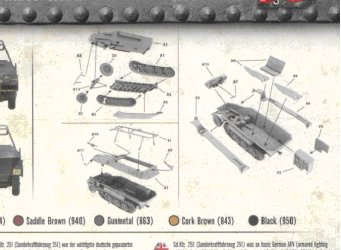
Above is an enlargement of the exploded-view assembly directions for
the FtF Sd.Kfz 251/6 Ausf. A. At lower left is attachment of the frame
antenna. At right we see that the large radio set replaces the rear
starboard-side seat. My references show that the radio was actually
mounted within a metal frame, not in a box-like cabinet.
With this enlarged view I see that the crew seats are not quite correct
based on my references. The crew seats for the Ausf. A and Ausf. B were
simple bench seats with a seat cushion and where attached to the hull
lower sides, without backrests. I guess for a wargaming kit it is fine
as is; for a display model the interior will need much rebuilding and
correcting.
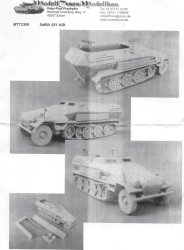
The Modell Trans Sd.Kfz 251/1 kit #72309 has no real assembly instructions,
this photocopy of the assembled model is helpful but not as sufficient
as good exploded view drawings. If you can acquire the assembly directions
for a 1/72-scale Revell or a Dragon Sd.Kfz. 251 Ausf. C model it will
be a considerable help. Notice that the two front visors are open, a
nice detail.
Rear body sections for the Sd.Kfz. 251 Ausf. A with side visors, and
a section for the Ausf. B variant without visors are both included with
this model. The Modell Trans kit has no decal markings.
The Kit Parts
The three First To Fight Sd.Kfz. 251 kits come with a basic twenty gray
color, injection molded, styrene plastic parts on three sprue. The FtF
Kit #053 for the Sd.Kfz. 251/4 has an additional sprue with 10 ammunition
boxes and crew figure parts on an additional sprue. First To Fight kit
#043 Sd.Kfz. 251/6 has an additional two parts for the radio and antenna
on a separate sprue.
The Model Trans Sd.Kfz 251/1 kit #72309 has about 40+ light amber color
cast resin parts on multiple pour plugs. I counted the parts several
times and "about 40" is the best I will commit to.
Below is a scan of the gray plastic FtF upper hull (part A1) at far
right, then moving left we have the light amber color Model Trans resin
hull parts. For comparison we have a pale amber color Revell Sd.Kfz.
251 Ausf. C upper hull part and then a light gray Dragon Sd.Kfz. 251
Ausf. D upper hull. We see quite a progression of body designs from
1939 to 1945, largely to simplify construction and reduce the number
of parts.
All four hulls appear to be about the same width which is a good sign
for scale. Keep in mind though, I tend not to be a rivet counter nor
do I take a caliper to the parts. I see modelers as an "enginee"r
type, or an "artist" type, and occasionally a modeler is superb at both
aspects. I tend toward the "artist", so if it looks well proportioned,
I am happy.
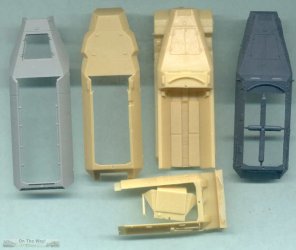
The FtF Sd.Kfz. 251 upper hull at far right looks good and well proportioned.
It appears to be more a wargaming model so the visors are molded closed,
the interior details are simplified and spartan, and tools are molded
onto the hull. Next to the hull driver viewports are molded on turn
signals. For the infantry/passenger compartment sides, the viewports
have no interior detail. We'll have to scratchbuild many other inside
parts like the seats flanges connecting the driver and compartment bodies,
storage boxes and rifle stowage. For a gaming model we can dispense
with detailing, for a display model I'd rebuilt the driver's seats too.
Moving to the left, the resin Modell Trans Revell Sd.Kfz. 251 Ausf.
A hull has open front driver's visors, the bench seats molded in, but
it still needs the long shelf for the packs mounted on the wall. Below
the Modell Trans lower hull part is one of two upper rear hull sections
included with this resin model. One part is for the Ausf. A with side
visors, and one is for the Ausf. B. For the infantry/passenger compartment
sides, the Ausf. B viewports have some simple interior visor detail;
I can't guarantee this interior detail is accurate, but I cannot prove
it is inaccurate either. We'll have to scratchbuild many inside parts
like the flanges connecting the driver and compartment bodies, storage
boxes and rifle stowage.
Also included in this above scan we see the rear hull part with molded
in closed doors. Being a resin kit and with no assembly instructions,
the parts have no numbers. On the nose of the Modell Trans hull and
again on the Dragon hull we have a good view of the joint between the
nose and the engine sections.
For comparison, the amber color Revell plastic Ausf. C hull displays
the wide and distinctive air vent hoods on the side of the engine compartment.

This scan above shows the main sprue (Sprue-A) for the First To Fight
kit #040 Sd.Kfz. 251 model kits. At upper right is the upper and lower
hulls parts A1 and A2. The lower hull has the driver's seats and gear
shift area molded in, but I do not see any interior door detail. Lower
right are the long mudguards (parts A3 and A4) with a few molded-on
tools and headlights. At lower left are the four seats with backrests
(parts A6) for the infantry in the rear open compartment, however these
seats should not have backrests, just simple bench seats. Continuing
clockwise, is the dashboard and firewall part A13. Above the dashboard
part is the front wheels axle (part A12) for the front wheels.
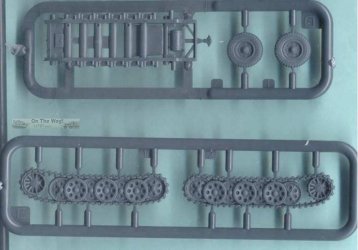
Above are the other two sprues that come with each of the First To Fight
kit #040 Sd.Kfz. 251 model kits. Sprue D at top has the torsion bar
and frame and the roadwheels. I guess that this sprue is also common
to an Sd.Kfz 11 medium prime mover kit. Sprue E holds the one-piece
wheels and track assembly; this sprue should also be common with a Sd.Kfz
11 model kit. It looks well done for a gaming kit. A nice touch for
just a little extra work would have molded the three outer roadwheels
separate like Modell Trans does, so the whole assembly would have a
little more depth when assembled.
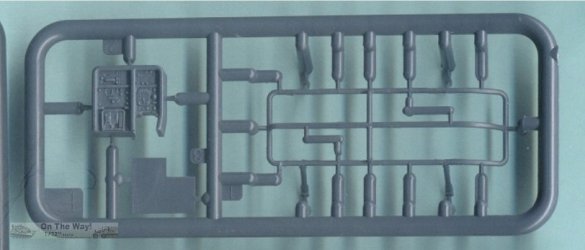
This Sprue-I First To Fight kit #043 Sd.Kfz. 251/6 is what turns kit
#40, the standard Sd.Kfz. 251/1 kit, into Kit 43, the radio and command
vehicle. At left are the two radio cabinet parts. From historical photos
the radio set should be individual parts stacked in a tubular frame.
At right is the frame antenna. Additional modifications for the Sd.Kfz.
251/6 is a change in crew seating.
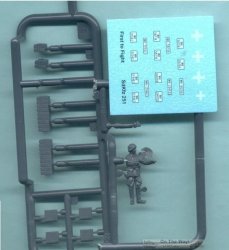
Above is what makes the First To Fight's kit into the infantry gun ammunition
vehicle Kit 053 Sd.Kfz. 251/4. Sprue-G contains one crew figure and
ammunition boxes for the 7.5-cm le IG 18 gun. With a little work this
model can be modified for the 3.7-cm Pak, the leFH 18 howitzer, and
the 5-cm PaK guns.
The two-part crew figure is descent, but not great. The figure reminds
me of some of Hasegawa's and ESCI's 1/72 scale figures of years past,
especially in the off-shape of the helmet.
At upper right is the water slide decal sheet which is a common set
of markings for all three of the FTS Sd.Kfz 251 kits I have. There are
five sets of license plate markings; does this indicate two more FtF
Sd.Kfz 251 kits are to be released?
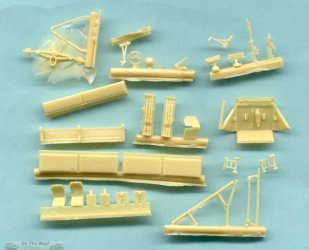
Here is a representative smattering of cast resin parts from the Model
Trans Sd.Kfz 251/1 Ausf. A/B, kit #72309. The casting is beautiful.
At right of center is the hull rear showing the inside detail with a
fire extinguisher and door hinge; and the two delicate door hinge parts
below. The inaccurate rear doors were always a weak part of the old
Esci Sd.Kfz 251/1 Ausf. C kit. Above the hull rear parts is a pour plug
with driver's visor, MG34 machine guns, and machine gun mounts. Modell
Trans, Revell and Dragon rendered these rear doors and complicated hinges
well. At lower left are the driver and commander seats. At lower right
is the front bumper used on the Ausf. A and Ausf. B halftracks, and
the axle.
Perhaps because of a lack of good references, this kit has features
of the Ausf. C rather than the Ausf. A and Ausf. B halftracks. An example
of this are the bench seats and the backrest storage bin in center and
left, The Ausf. A and B halftrack had simple wood bench seats and no
backrest or bin. The rifle rack with three rifles in center of this
scan is incorrect; for the Ausf. A the rifles should be attached individually
with brackets onto the hull interior walls.
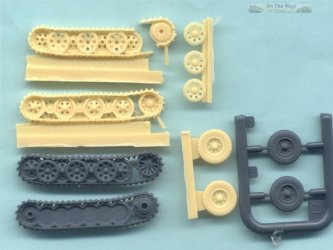
Above is a comparison of the suspension parts - amber resin Modell Trans
kit, and the gray styrene FtF parts. The Modell Trans set includes separate
outer roadwheels which is a nice touch for accuracy that I wish FtF
had emulated. The FtF tracks have track teeth which is good.
For the front wheels and tires, both are good but I believe that the
Modell Trans wheels are more accurate. These wheels, and track and suspension
can also be used with an Sd.Kfz. 11 towing tractor.
Timothy
Lau adds:
In
terms of building the interior, the reader may want to look at this
exchange I had with Bruce Culver, who, of all people, would know
what the interior looks like.
The FtF interior has some serious deficiencies (read: completely wrong).
The Modell Trans looks a bit better, but I don't have a sample on
hand.
Anyway, given the lack of references on these early versions of the
251, the builder may as well just use the 1/35
ICM kit instructions as a guide to the extent that Bruce Culver
can declare the ICM 1/35 kit "completely accurate".
Conclusion
Both are good representative kits of the Sd.Kfz 251 mittlere Schützenpanzerwagen.
My personal opinion is that the resin Modell Trans model should be tackled
by a more experienced modeler due to the fragility of the resin parts
and laborious work in cleaning up the resin parts and working with the
super glue.
I like the FtF model as it gives us the choice of building a simple
wargaming kit, or an opportunity to super-detail the model, such as
by replacing the suspension with that from a 1/72 scale Hasegawa, Dragon,
or Revell Sd.Kfz 251 model kit.
References
Below is a page from the accompanying booklet for the First To Fight
Kit 43, Sd.Kfz 251/4 kit, but not with my other FtF Sd.Kfz 251 kits.
In Polish the booklet gives vehicle history and information on the kit
assembly. Considering the worldwide sales of these model kits, accompanying
translation in several other languages would be nice.
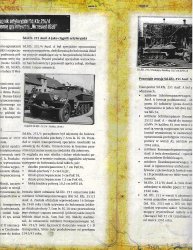
For a possible reference, below are some photos of an Sd.Kfz 251/1 Ausf.
B conversion I produced years ago using the forward hull parts from
the Fujimi Sd.Kfz 251 kit and the rear hull parts and suspension of
the ESCI Sd.Kfz 251 Ausf, C kit. I produced this when there were no
resin or plastic kits of the Sd.Kfz 251 Ausf. A or Ausf. B that I knew
of. The Fujimi model is 1/76-scale in length but approximately 1/72
scale in width so mating it with the 1/72-scale ESCI model is possible.
The Fujimi nose is short for 1/72 so it is not a perfect conversion
project.
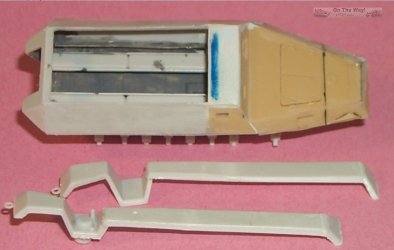
The raw unpainted conversion above, and a mostly-completed gray-primer
painted kit below. This is a good view of the corrected passenger bench
seats: simple bench seats with gear stowed underneath, and a narrow
shelf above the seat for the infantry packs which served as a backrest.
In the photo below we can see the single rifles bracketed to the upper
side walls. The rear compartment, suspension and long mudguards are
from a ESCI Sd.Kfz 251 Ausf. C kit.
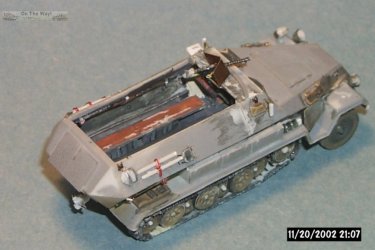
Note no visors on the hull side indicating this to be an Ausf, B, and
the scratchbuilt handtools. References for the Sd.Kfz 251/1 Ausf. A
and B are not as plentiful as for later variants so please forgive any
minor inaccuracies.
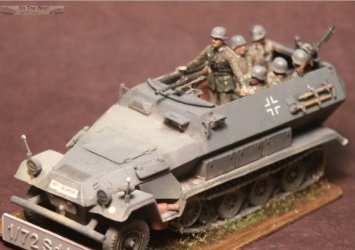
The completed conversion and rebuild of the Fujimi model.
[1] Panzer Tracts No.15-2: mittlerer Schuetzenpanzerwagen Ausf. A to
C, 1939 to 1942, by Thomas Jentz & Hilary Doyle. This is a companion
book to Panzer Tracts No. 15-3, and both books expand on and have replaced
Panzer Tracts No. 15.
[2] Schutenpanzerwagen, War Horse of the Panzer Grenadiers, by Horst
Scheibert (1992), Schiffer Military History. An inexpensive softcover
with period photos and coverage of the Sd.Kfz 251 and its smaller cousin
the Sd.Kfz. 250.
[3] wikipedia
[4] wikipedia
[5] panzerworld.com
[6] The (HANOMAG)
Sd. Kfz. 251 website, by Piet van Hees (formerly located at http://www.geocities.com/MotorCity/Pit/3515/251/index.htm).
This excellent website is dedicated to the Sd.Kfz. 251 halftrack. [According
to Jentz & Doyle, 'Hanomag' was never an official or slang term
for the 251, but apparently is a post war term based on one of the many
manufacturers of this vehicle.]
|